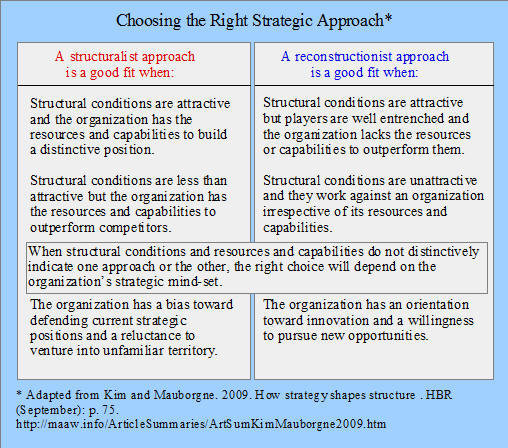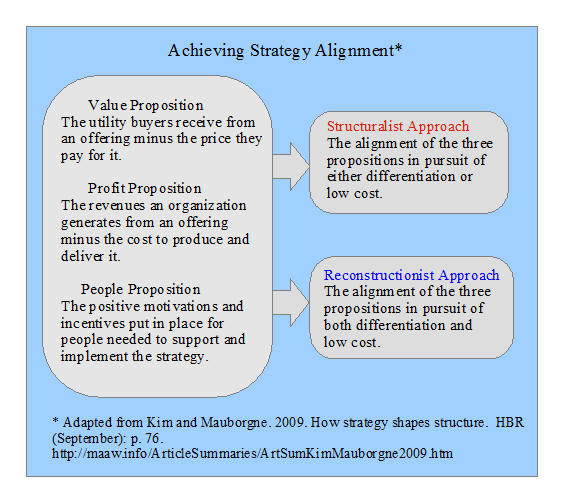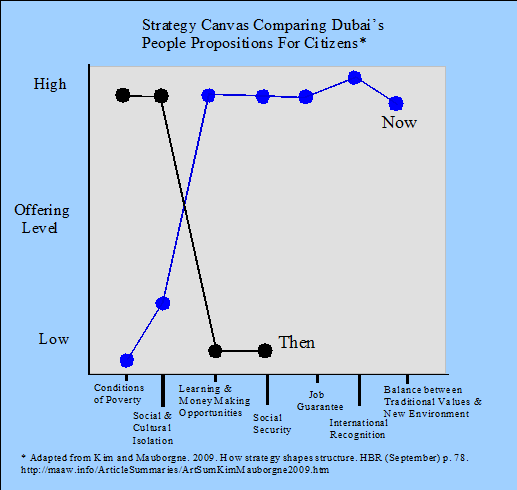
Summary by James R. Martin, Ph.D., CMA
Professor Emeritus, University of South Florida
Change and Risk Management Main Page |
Strategy Related Main Page
Note: For some background that will improve your understanding of this article, see my summary of Kim and Mauborgne's 2004 article, Blue Ocean Strategy.
The development of a corporate strategy is usually based on a structuralist approach where the industry and environmental conditions are analyzed along with the strengths and weaknesses of the firm and its competitors. A strategic position is developed to either differentiate or pursue a low cost position based on the underlying logic that the company's strategic options are bounded by its environment, i.e., that structure shapes strategy. A blue ocean strategy, on the other hand is based on the reconstructionist logic that strategy can shape structure. The purpose of this article is to describe how an organization can be aligned behind the reconstructionist approach to deliver high value and a sustainable performance.
What is the Right Strategic Approach?
The right strategic approach for a company depends on:
1. the structural conditions in which the organization operates,
2. the organization's resources and capabilities, and
3. the organization's strategic mind-set.
The illustration below shows the combinations of structural conditions, organization resources, capabilities, and strategic mind-sets that determine the appropriate strategic approach. For example, when structural conditions are unfavorable, or the organization lacks the resources and capabilities to outperform competitors, the organization needs to create new market space.

The Three Strategy Propositions
A strategy's success depends on three propositions:
1. A value proposition that attracts buyers,
2. A profit proposition that allows the organization to make money based on the value proposition, and
3. A people proposition that motivates the workers to execute the strategy.
A strategy is what the organization offers to buyers and how it intends to benefit from this offering, while the people who execute the strategy determine its effectiveness. Kim and Mauborgne define strategy "as the development and alignment of the three propositions to either exploit or reconstruct the industrial and economic environment in which an organization operates." To produce a high-performing and sustainable strategy, the propositions must be complete and consistent. A weak value or profit proposition will result in a formulation failure. On the other hand, a weak people proposition is likely to result in an execution failure.
Organizations that adopt the structuralist approach need to align the three propositions with either a differentiation or low cost position. However, using the reconstructionist approach, the organization aligns all three strategy propositions to pursue both differentiation and low cost to break the value-cost tradeoff.

The organization's top executives must make sure that each proposition is fully developed recognizing that a functional bias (e.g., marketing, manufacturing, human resources) may cause some managers to miss the larger strategic picture.
Achieving Blue Ocean Strategy Alignment
Kim and Mauborgne use the city-state of Dubai to illustrate how the Arab emirate used blue ocean strategy to reconstruct their economic environment to yield one of the fastest growing economies in the world. In less than 30 years, Dubai emerged from a desert environment of sheep herders living in thatched huts, to a premier tourist and business destination. They did it by aligning the three propositions around differentiation and low cost.
Dubai's Value Proposition
Dubai's value proposition is based on unbeatable incentives for investors. The government allows 100% foreign ownership and free repatriation of capital and profits, no import or re-export duties, and a corporate tax rate of zero for the first 15-50 years that can be extended. Companies can get a license to do business in less than a half hour. They offer world-class air and shipping services, and have a transparent legal system based on British law with all documentation in English. The significance of Dubai's value proposition for foreign investors is illustrated by comparing the strategy canvases of Dubai and Shanghai, China's biggest commercial center.

Dubai's Profit Proposition
One might think the main source of Dubai's profits are derived from oil and natural gas, but only 5% of its revenue comes from this source. The main source of Dubai's revenue comes from its investments in infrastructure that support foreign investors' activities including shipping and port services, transport, tourism, aviation, real estate development, export commerce, and telecommunications. For example, DP World (80% owned by government) operates Jebel Ali Port (where 6,000 companies are based) and 50 ports in 31 countries. But Dubai's strategy is not just based on differentiation, they also simultaneously pursue low cost. Although 80% of the population is foreign, they restrict citizenship to keep social liabilities to a minimum. And since it is part of the United Arab Emirates, it does not need a military, diplomatic corps, or monetary agency. Keeping government overhead low allows it to reinvest in businesses that give foreign investors an even greater reason to come to Dubai. Comparing the profit propositions for Dubai and Oil-based Arab countries illustrates how Dubai has broken the value-cost tradeoff.

Dubai's People Proposition
Dubai has been reconstructed into a cosmopolitan state with over a million people from over 100 countries. The people proposition for citizens includes generous social security, a guaranteed government job, medical care, sickness and maternity benefits, child care, free or subsidized education, pensions, unemployment benefits, and some housing and disability benefits. Citizens receive free plots of land along with interest free loans or grants to build homes. Arab values and culture are maintained in schools that provide both Islamic religious studies and a modern education. The strategy canvas graphic below shows a before and after picture of what the Dubai citizens had 30 years ago, compared to what they have now.

Dubai's people proposition for expatriates is perhaps equally compelling and offers foreign talent a rich and unique experience at low cost. Some examples include a generous income, no income tax, cheap housing, outright property ownership, and a multicultural environment.
When Strategy is Not Aligned
A failure to align the three strategy propositions is a key reason many innovations fail to create sustainable businesses. Napster's 1999 easy-to-use music indexing software and Apple's i-Tunes Music store are provided as examples. Although Napster's value proposition was innovative, the company failed to build a win-win relationship with the music industry and was forced to shut down under a barrage of copyright infringement suits. Apple's i-Tunes Music store offered a similar compelling value proposition, but also developed an attractive people proposition with the five major music companies ensuring that music was downloaded with copyright protection and paying them part of the revenue for every song downloaded. Apple's profit proposition was based on the revenue they earned from the downloaded music and the boost to iPod sales generated by their i-Tunes business. The lesson is that the difference between success and failure is strategy alignment.
The Leadership Challenge
The challenge for leaders is to recognize that strategy can shape structure under certain circumstances. A structuralist approach will be the appropriate approach for some business units, while a reconstructionist approach will be more appropriate for other units. Therefore, leaders need to choose the right strategic approach for each business, and insure that the three strategy propositions are properly aligned.
____________________________________________
Related summaries:
Johnson, M. W., C. M. Christensen and H. Kagermann. 2008. Reinventing your business model. Harvard Business Review (December): 50-59. (Summary).
Kim, W. C. and R. Mauborgne. 1997. Value innovation: The strategic logic of high growth. Harvard Business Review (January-February: 103-112. (Summary).
Kim, W. C. and R. Mauborgne. 1999. Creating new market space: A systematic approach to value innovation can help companies break free from the competitive pack. Harvard Business Review (January-February): 83-93. (Summary).
Kim, W. C. and R. Mauborgne. 2002. Charting your company's future. Harvard Business Review (June): 77-83. (Summary).
Kim, W. C. and R. Mauborgne. 2004. Blue ocean strategy. Harvard Business Review (October): 76-84. (Summary).
Kim, W. C. and R. Mauborgne. 2015. Red ocean traps: The mental models that undermine market-creating strategies. Harvard Business Review (March): 68-73. (Summary).
Magretta, J. 2002. Why business models matter. Harvard Business Review (May): 86-92. Explains the difference between a business model and a competitive strategy. (Summary).
Porter, M. E. 1980. Competitive Strategy: Techniques for Analyzing Industries and Competitors. The Free Press. (Summary).
Porter, M. E. 1987. From competitive advantage to corporate strategy. Harvard Business Review (May-June): 43-59. (Summary).
Porter, M. E. 1996. What is a strategy? Harvard Business Review (November-December): 61-78. (Summary).
Porter, M. E. 2001. Strategy and the internet. Harvard Business Review (March): 63-78. (Summary).